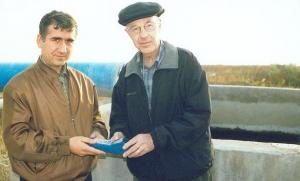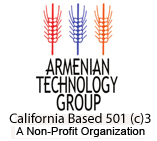Sis -- Reclamation Project Continues to Make Strides
November 7, 2003

Sis, Province of Ararat, Armenia — In Armenian legend, when Noah descended from Mt. Ararat (affectionately called ‘Masis’ by the Armenians), he look out over the dry land and declared, “Behold, the mountains and hills have appeared!” This place was named Yerevan, where Noah planted the first grapevine after the Great Flood.
Sis village, located on the Ararat plain not far from Yerevan, is named after the lesser of Ararat’s two peaks. In this area, including the neighboring town of Masis, Armenians have lived and farmed since the time of Noah.
In Soviet times, however, Sis was mostly inhabited by Azeris. After the breakup of the Soviet Union, unrest and war in Nagorno Karabagh resulted in the Azeri population of Armenia leaving for Azerbaijan.
Challenges faced by Sis Armenians
In 1989, following brutal pogroms by Azeris in Baku and Sumgait, the remaining Armenians there fled abroad; many of those who came to Armenia settled in and around the village of Sis. Overwhelmed by the sudden influx of refugees, the Armenian government was unable to offer sufficient aid to relieve the desperate situation faced by these new residents in Sis and other towns and villages in Armenia.
With the collapse of the Soviet Union, most businesses in Sis were unable to function. Earning a living in agriculture was also difficult, due to the alkaline condition of the surrounding soil. In 2001, a far-sighted member of the community, Mischa Lazkiyan, founded the Sis Benevolent Union (SBU) in order to improve the social and financial situations in the area. “We needed to find ways to keep people from leaving our village,” Lazkiyan said.
In collaboration with the World Food Program (WFP), the Armenian Technology Group (ATG) started work in Sis on February 20th, 2001. A land reclamation program was initiated to transform the alkaline soil around Sis into productive farmland. WFP paid village farmers for their work in the program. The amelioration of the once-barren fields had begun.
ATG, SBU launch innovative project
To ensure the success of the amelioration program, ATG embarked on a companion project in 2003 that could, in turn, benefit farmers throughout the entire Ararat Valley. Gevorg Gabrielyan, ATG in-country director, and Hratch Javadyan, director of the Foreign Agricultural Relation Agency (FARA), took Gourgen Yeghiazaryan to Sis to assess the progress of the reclamation project. Yeghiazaryan, who holds a doctorate in agronomy ands works with the National Academy of Sciences, is the manager of the Small Farm Water Management Research Center. “Dr. Yeghiazaryan’s expertise made him the perfect choice to direct the program,” Gabrielyan said.
Under Yeghiazaryan’s direction, work was undertaken during the fall. Yeghiazaryan worked closely with Lazkiyan and Sergey Khachatryan, manager of the Sis project. Former ATG in-country director Roger Benton, now with the U.S. Department of Agriculture, was hired as a consultant. “ We wanted someone who understood the amelioration process we had already started,” Khachatryan said.
Plans were made to complete necessary work before winter set in. First, Sis farmers deep-plowed the land. According to Gabrielyan, without proper plowing (specifically, ‘perpendicular deep plowing’) and leveling, the project cannot succeed. “Otherwise, irrigation can cause secondary salinization.”
Next, organic matter, including gypsum and cow manure, was added. “This helps water flow properly through the soil, and keeps the nature chemicals in balance,” stated Yeghiazaryan.
At this point, the land was divided into 18 checks, ten meters apart. Irrigation followed the slope of the land. According to Roger Benton, a slight land slope is preferable to a completely level field. “It assists the flow and percolation of water. Also, the flatter the soil, the bigger the head of water needed.”
Since high pH content can harm the amelioration process, the water is tested before irrigation. “The water tested at 6.3,” Benton said. “This is a good level for successful amelioration.” The first stage included flushing the soil to a depth of one meter, to lessen the salt content and allow the water to flow more freely. A second flushing at a depth of thirty centimeters was then done. “The timing of the irrigation is very important. The field needs to be irrigated before the onset of winter.”
Far-reaching benefits for Ararat Valley farmers
The innovative methods used in the ATG-sponsored amelioration program in Sis stand to benefit farmers throughout the entire Ararat Valley. Due to the flatness of the land and the marshes along the Arax River, the naturally occurring salts accumulate on or near the soil surface, especially in the upper 20-30 centimeters. This has caused serious problems for farmers throughout the area, as up to 10,000 hectares of land need amelioration. “This project is important for all of Armenia,” Gevorg Gabrielyan stressed. “If successful, this will be the least expensive method in Armenia for land reclamation.”
The program is primarily funded by ATG, with SBU and WFP also contributing. Currently, ATG and FARA are discussing the possibility of the latter’s further participation in analysis and technical assistance for the Sis amelioration program. FARA implements projects approved by the USDA.
In Sis, Mischa Lazkiyan expects to see positive results in the current phase of the program by May 2004. “Each section of the land will be carefully tested for salt content. On the best soil, we will sow wheat.”
Tomatoes, barley, corn, and other crops will be planted on the remaining land, each according to the quality of the soil. Also, an indigenous water reed known as yeghek in Armenian can be planted in saline soil. Flour derived from this plant can be used for medicinal purposes. Fruit trees will be planted around the border of the 25 hectares undergoing amelioration to protect the land and its crops from the wind.
“Besides providing fruit, the trees will add to the beauty of our land,” Lazkiyan said. “With the hard work of the farmers and villagers of Sis, and the assistance of our friends at ATG, our village is alive, and has hope for the future.”
For more information about how you can help Armenia’s farmers, contact the ATG office at (559) 224-1000 or by e-mail (info@atgusa.org). Tax-deductible donations can be sent to ATG; 1300 E. Shaw, Suite 149; P.O.Box 5969; Fresno, CA 93755-5969.
You may also donate to ATG online.

Follow Us